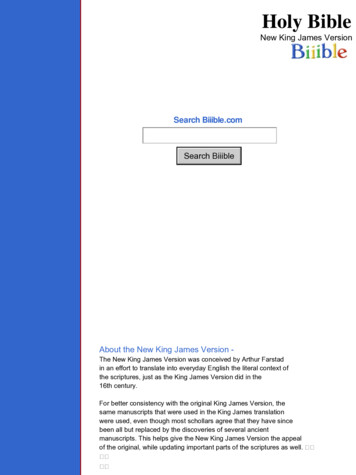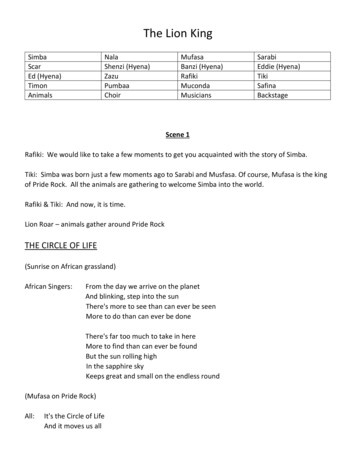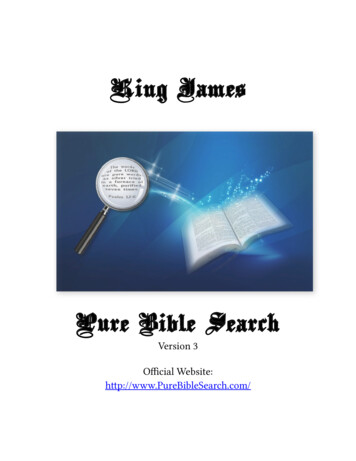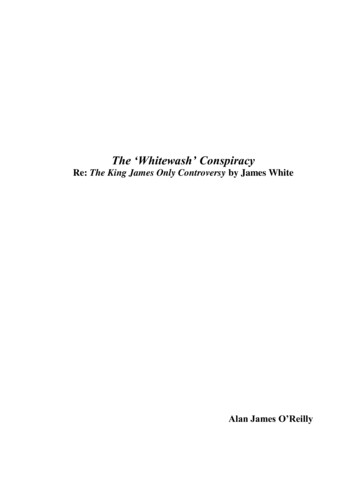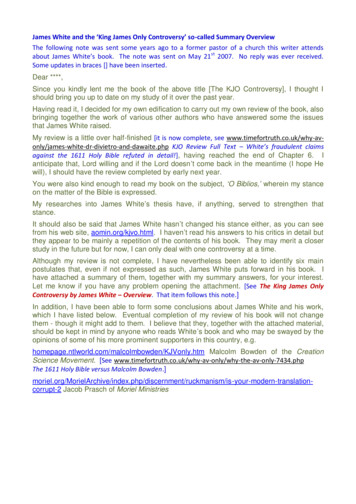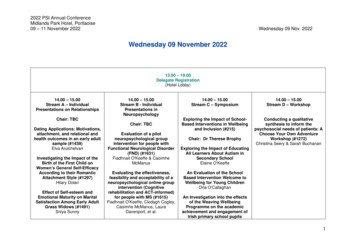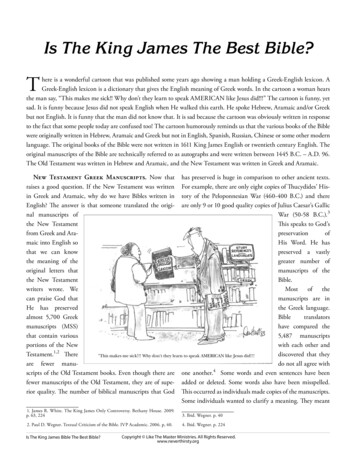
Transcription
Is The King James The Best Bible?There is a wonderful cartoon that was published some years ago showing a man holding a Greek-English lexicon. AGreek-English lexicon is a dictionary that gives the English meaning of Greek words. In the cartoon a woman hearsthe man say, “This makes me sick!! Why don’t they learn to speak AMERICAN like Jesus did!!!” The cartoon is funny, yetsad. It is funny because Jesus did not speak English when He walked this earth. He spoke Hebrew, Aramaic and/or Greekbut not English. It is funny that the man did not know that. It is sad because the cartoon was obviously written in responseto the fact that some people today are confused too! The cartoon humorously reminds us that the various books of the Biblewere originally written in Hebrew, Aramaic and Greek but not in English, Spanish, Russian, Chinese or some other modernlanguage. The original books of the Bible were not written in 1611 King James English or twentieth century English. Theoriginal manuscripts of the Bible are technically referred to as autographs and were written between 1445 B.C. – A.D. 96.The Old Testament was written in Hebrew and Aramaic, and the New Testament was written in Greek and Aramaic.New Testament Greek Manuscripts. Now thatraises a good question. If the New Testament was writtenin Greek and Aramaic, why do we have Bibles written inEnglish? The answer is that someone translated the original manuscripts ofthe New Testamentfrom Greek and Aramaic into English sothat we can knowthe meaning of theoriginal letters thatthe New Testamentwriters wrote. Wecan praise God thatHe has preservedalmost 5,700 Greekmanuscripts (MSS)that contain variousportions of the NewTestament.1,2 Thereare fewer manuscripts of the Old Testament books. Even though there arefewer manuscripts of the Old Testament, they are of superior quality. The number of biblical manuscripts that Godhas preserved is huge in comparison to other ancient texts.For example, there are only eight copies of Thucydides’ History of the Peloponnesian War (460-400 B.C.) and thereare only 9 or 10 good quality copies of Julius Caesar’s GallicWar (50-58 B.C.).3This speaks to God’spreservationofHis Word. He haspreserved a vastlygreater number ofmanuscripts of theBible.Most of themanuscripts are inthe Greek language.Bibletranslatorshave compared the5,487 manuscriptswith each other anddiscovered that theydo not all agree with4one another. Some words and even sentences have beenadded or deleted. Some words also have been misspelled.This occurred as individuals made copies of the manuscripts.Some individuals wanted to clarify a meaning. They meant1. James R. White. The King James Only Controversy. Bethany House. 2009.p. 63, 2243. Ibid. Wegner. p. 402. Paul D. Wegner. Textual Criticism of the Bible. IVP Academic. 2006. p, 40.4. Ibid. Wegner. p. 224Is The King James Bible The Best Bible?Copyright Like The Master Ministries. All Rights Reserved.www.neverthirsty.org
well by their addition, but they introduced a variation to theoriginal text. Dr. Kurt Aland has stated that the originalwording and even the additions do not “simply go away” onsubsequent copies.5The 5,487 Greek manuscripts include papyri, uncialand minuscule manuscripts. The texts have been classifiedas being either of the Western (from western Europe), Byzantine (from Constantinople), Caesarean (from Caesarea)or Alexandrian text-types (from Alexandria).6 Amongthese manuscripts, the most highly regarded are the CodexSinaiticus, Codex Alexandrinus and the Codex Vaticanus.It is important to note that the names do not necessarilyindicate the location from which they were copied but wherethey were found.7 A careful investigation reveals that variousmanuscripts originated from Africa, Egypt, the Middle Eastand Europe.8The Codex Sinaiticus or “Aleph” was written in the fourthcentury and is on display at the British Museum in London.9The Codex Alexandrinus, known as “A,” was written in thefifth century and is on display at the British Museum inLondon.10 The Codex Vaticanus, known as “B,” was writtenin the fourth century and is on display at the Vatican libraryin Rome. This codex was written in the fourth century andkept at the Vatican until 1481. It was released to the nonRoman Catholic world in 1889-1890.11 It should be notedthat there are many other manuscripts of fine quality.Copes of the New Testament also exist in other languagessuch as Latin and Syriac (Aramaic), Coptic, Ethiopic, Armenian, Georgian, Nestorian, Arabaic, and others for example.12 The total number of such manuscripts is 9,000. Thereare also 2,000 lectionaries.13 God is so wonderful that even5. Ibid. White. p. 786. Ibid. White. p. 70-717. J. Harold Greenlee. Introduction to New Testament Textual Criticism. Hendrickson Publishers. 1995. pp. 29-30.8. Ibid. Wegner. p. 242if we did not have any Greek manuscripts, we could reconstruct the Bible except for eleven verses from the 36,289quotes from the early church fathers of the first three centuries.14Process of Textual Criticism. Using the availablemanuscripts modern day translators have reconstructed or“compiled” various Greek New Testaments by following aset of rules such as 1) selecting some of the oldest and bestmanuscripts and 2) comparing them to one another in orderto determine the correct reading of the original MSS. Manyother factors are also considered in the process of creatinga “compiled text” as explained by Geisler and Nix in theirbook Introduction to the Bible15 and also Paul D. Wegner in hisbook Textual Criticism of the Bible.16 The translators considerexternal factors such as the heritage, date and geographical location of the manuscripts. The internal considerationsinclude the difficulty of the Greek reading, brevity of thereading, verbal dissonant and the sophistication of the reading. The correct Greek words are carefully selected in order tocreate a new “compiled” Greek manuscript of the entire NewTestament which is technically called an Apparatus. We willalso call them “compiled” texts since that more accuratelycommunicates that the new Greek text has been compiledor pieced together from many different Greek manuscripts.For example, the Textus Receptus (TR) is an Apparatus andnot an autograph.Due to the translators diligent efforts, modern “compiledtests” are 99.99% accurate, with only about twenty placesin the New Testament that are uncertain.17 Now considerHomer’s Iliad which was written about 900 B.C. Todaywe have only 500 copies of the Illiad with a textual accuracy that is 90%.18 In comparison to the Bible with 5,487Greek manuscripts, that is poor. Now that reveals our Bibleis incredibly accurate. Even better news is that none of theuncertainties affect any doctrine - anything that we believe.That is wonderful proof that God has preserved His Word.9. nai.html14. Ibid. Geisler & Nix., p. 35910. ex.html15. Ibid. Geisler & Nix., pp. 367-37011. Bruce M. Metzger. The Text of the New Testament. Oxford. 1968. p. 4716. Ibid. Wegner pp. 229-25512. Geisler & Nix. Introduction To The Bible. Moody Press. 1973., pp. 316-32817. Ibid. Geisler & Nix, p. 365-36613. Ibid. Geisler & Nix,, p. 35918. Ibid. Geisler & Nix, p. 367Is The King James Bible The Best Bible?2www.neverthirsty.org
The 1611 KingGeorgia, Arabia andOriginal AutographsJames Version Bible,for other peoples.20which is written inThe earliest knownEnglish, is translatedEnglish version of anyAlexandrianByzantineCaesareanWesternfrom the TR, whichportion of the Bibleis a Greek text, thatwas the Aldhelmthe translators cre(A.D.639–709).21ated or “compiled”It contained onlyfrom a subset ofthe book of Psalms.AutographsRevised Syriac Textthe existing 5,487Many do not realizeCopies of MSSByzantine TextGreek manuscripts.that the King JamesComplied TextApparatus“Modern”BiblesBible was not theIllustration of the Creation of an Apparatus or “Compiled” Texthave also been transfirst Bible translatedlated from otherinto English from the“compiled” Greek texts or Apparatuses such as the UBS Greek original languages. In the “Bibliographical Introduction” toNew Testament 3rd edition, United Bible Societies 4th edi- the reproduction of the 1611 King James Bible, the publishtion or the Nestle-Aland 27th edition. Other “compiled” ers describe other English Bibles that had been publishedinto English between A.D. 1380-1582.22 The “Bibliographitexts include the Critical Text and the Majority Text.The reader should note that this is not a complete list of cal Introduction” refers to the following English Bibles that“compiled” Greek texts. It is important to note that the TR were translated before the 1611 version, 1397 Wyclifiteis not the Majority Text, which has a different Apparatus.19Bible,23 1516 Tyndale’s New Testament,24 1535 CoverdaleEarly Bible Translations. From these “compiled” Bible,25 1537 Matthew Bible,26 1539 The Great Bible,27 1557texts translators have created English Bibles so that English The Geneva Bible,28 1572 The Bishop’s Bible,29 and Thereaders can understand what the original writers of scripture Rheims New Testament.30 This reveals that the 1611 Kingwrote. Most English readers do not know Hebrew, Aramaic James Version Bible was not the first English Bible.and/or Greek. So Bibles are created from the original lanTextus Receptus Was Rejected. So why was theguages so that we can understand them. In Nehemiah 8:8 1611 King James Version Bible created? Some people todaywe discover that the priest Ezra read the Law of Moses to the question why newer Bible translations are published sayingpeople and then translated it.that the newer ones are not needed. James Froude wrotea biography on the Life and Letters of Erasmus in 1900. HisThey read from the book, from the law of God, translating to givethe sense so that they understood the reading. Neh. 8:8 (NASB)20. Ibid. Geisler and Nix. p. 316-328.21. http://en.wikipedia.org/wiki/AldhelmWhy did Ezra translate what he read? The answer is simple,because the people did not understand the original language. Consequently, we should not be surprised that newBibles have been created over the hundreds of years - mentranslated portions of the scriptures into the languages ofthose living in Syria, Egypt, Ethiopia, Germany, Armenia,22. The Holy Bible, 1611 Edition. Hendrickson Publishers. 2010. p. 6.23. Ibid. The Holy Bible., p. 6.24. Ibid. The Holy Bible, 1611 Edition, p. 6.25. Ibid. The Holy Bible, 1611 Edition, p. 10.26. Ibid. The Holy Bible, 1611 Edition., p. 14.27. Ibid. The Holy Bible, 1611 Edition, p. 15.28. Ibid. The Holy Bible, 1611 Edition, p. 19.29. Ibid. The Holy Bible, 1611 Edition, p. 25.19. Ibid. Greenlee. p. 77.Is The King James Bible The Best Bible?30. Ibid.3www.neverthirsty.org
book is documented with numerous letters written by Erasmus. The letters are insightful into the thinking of Erasmus.James Froude reveals that Erasmus was criticized for creatinga newer and different Greek text, the TR. He writes this,James White summarizes the translators comments,One of the most eloquent arguments against KJV Onlyismis provided, ironically by the translators [of the King JamesBible] themselves . . from the preface of the 1611 KJV,Pious, ignorant men had regarded the text of the Vulgateentitled The Translators to the Reader.”33as sacred, and probably inspired. Read it intelligently theycould not, but they had made the language into an idol, andthey were filled with horrified amazement when they foundin page after page that Erasmus had anticipated moderncriticism, correcting the text, introducing various readings,and retranslating passages from the Greek into a new version. He had altered a word from the Lord’s Prayer. Horrorof horrors! He had changed the translation of the mysticLogos from Verbum into Sermo, to make people understandwhat Logos meant.31The King James Only advocates should note that the LatinVulgate Only advocates were critical of Erasmus’ works, justas they are of the modern Bibles.The translators of the TR and the subsequent 1611 KJVBible believed that a new translation was needed as evidenced in the “Translators To The Readers” section of theoriginal 1611 King James Version Bible. Even the translators defended their creation of a new Bible saying that it waseasier to read and more accurate.Translation it is that openeth the window, to let in the light;It is clear that the KJV translators thought a better translation was needed. Therefore, they created a new “compiled”text called the Textus Receptus. Now we should ask, why areKJV Only advocates critical of every newer “compiled” textwhen the originators of the TR struggled against the samecriticism? Are we to assume that a KJV is sacred text andthat God has not in the past and cannot in the future guidemen to provide a better translation?Textus Receptus and Erasmus. Mr. David Daniels,a KJV Only advocate, condemns the Codex Alexandrinussince it is used by the Roman Catholics.34 Consequently,he condemns the modern “compiled” texts since they selectively use the codex. But it is widely believed that DesideriusErasmus, the editor of the TR, was a Roman Catholic priestall his life.35 Does that taint the integrity of both the TRand 1611 KJV Bible? Mr. Daniels, a KJV Only Advocate,claims that Desiderius Erasmus eventually left the RomanCatholic Church.But the following letters from Erasmus reveal that he wasa Catholic until his death. In March 25, 1520 Erasmus wrotethis,that breaketh the shell, that we may eat the kernel; thatputteth aside the curtain, that we may look into the mostChrist I know; Luther I know not. The Roman Church Iholy place; that removeth the cover of the well, that we mayknow, and death will not part me from it till the Churchcome by the water, even as Jacob rolled away the stone fromdeparts from Christ.36the mouth of the well, by which means the flocks of Labanwere watered [Genesis 29:10]. Indeed, without translationI have sought to save the dignity of the Roman Pontiff, theinto the vulgar tongue, the unlearned are but like children athonour of Catholic theology, and the welfare of Christen-Jacob’s well (which was deep) [John 4:11] without a bucket ordom . . I have not deviated in what I have written one hair’s32something to draw with . . .33. Ibid. James R. White. pp. 117-118.34. David W. Daniels. Answers To Your Bible Version Questions. Chick Publications. 2010. p. 30.31. James Anthony Froude. Life and Letters of Erasmus. London: Longmans,Green and Co., 1900., p. 227.35. Manfred Hoffmann, “Faith and Piety in Erasmus’s Thought,” Sixteenth Century Journal. 1989. 20#2 pp 241-258.32. Ibid. The Holy Bible, 1611 Edition, “Translators To The Readers”36. Ibid. Froude. p. 253.Is The King James Bible The Best Bible?4www.neverthirsty.org
breadth from the Church’s teaching.37The Pope’s author38ity as Christ’s Vicar must be upheld.I will bear anything39same text . . . were somehow “inspired” or at the very best“providentially guided” in their work. Yet none of these menever claimed such inspiration.42before I forsake the Church.In December 24, 1533, just before Erasmus died in 12 July1536, he wrote this,. . . they sing the old song. Erasmus laughs at the saints,despises the sacraments, denies the faith, is against clericalResearch has revealed that the TR is of Byzantine text-typeand has incorporated portions of the Latin Vulgate. F. H.A. Scrivener has documented that the Textus Receptus wascompiled from Minuscule 1, which is of the Caesarean texttype.43celibacy, monks’ vows, and human institutions. Erasmuspaved the way for Luther. So they gabble; and it is all lies.40Scrivener showed that some texts were incorporated from theVulgate (for example, Acts 9:6; Rev 17:4.8). Daniel B. Wal-Others will disagree with this conclusion stating that hewas neither Catholic or Protestant. But should we want theeditor of the TR to be a humanist?Origin of the Textus Receptus. The TR generallyfollows the Byzantine text-type.41 Unfortunately, the TRcould not take advantage of the three main codices and thethousands of Greek manuscripts that have been found sinceA.D. 1611. Desiderius Erasmus “compiled” the TR from asmall set of available manuscripts before his death in 12 July1536.lace enumerated that in 1,838 places (1005 are translatable)the Textus Receptus differs from the Byzantine text-type.44Dean Burgon, who is a supporter of the Textus Receptus, hasdeclared that the Textus Receptus needs correction in 150corrections in the Gospel of Matthew alone.45When Erasmus used the Latin Vulgate, he translated theLatin back into Greek. Consequently, he introduced errorsinto the TR and subsequently into the 1611 KJV. . . Erasmus used the same basic methods of textual-critical. . . As would be expected from such a procedure, here andstudy that modern scholars use. I am not saying he had thethere in Erasmus’ self-made Greek text are readings whichfull spectrum of textual tools available today, but he used thehave never been found in any known Greek manuscript -basic forms and methods of trying to arrive at the originalbut which are still perpetuated today in printings of the . .reading even as he collated what became known as the.Textus Receptus of the Greek New Testament.Textus Receptus.Even in other parts of the New Testament Erasmus occasionThe TR did not fall down out of heaven complete. Instead,ally introduced into his Greek text material taken from theDesiderius Erasmus, a classical scholar, used his best judg-Latin Vulgate. Thus in 9:6, the question which Paul asks atment in coming up with his Greek text, drawing from vari-the time of his conversion on the Damscus road, “And heous sources, accepting some readings and rejecting others astrembling and astonished said, ‘Lord, what wilt thou havehe saw fit. Anyone who believes the TR to be infallible mustme to do?’, was frankly interpolated by Erasmus from thebelieve that Erasmus, and the other men who later edited theLatin Vulgate. This addition, which is found in no Greek37. Ibid. Froude., p. 25442. Ibid. White. , p. 96.38. Ibid., Froude. pp. 267-268.43. F. H. A. Scrivener, A Plain Introduction to the Criticism of the New Testament, (George Bell & Sons: London 1894, vol. 2, pp. 183-184.39. Ibid., Froude., pp. 385.40. Ibid., Froude., pp. 411.44. Daniel Wallace, “Some Second Thoughts on the Majority Text,” BibliothecaSacra, July–September, 1989., p. 276.41. Ibid. White., p. 10645. J. W. Burgon, The Revised Revision. London 1883., p. 242, 548.Is The King James Bible The Best Bible?5www.neverthirsty.org
manuscript at this passage . . . became part of the TextusReceptus, from which the King James version was made inthese three Greek codices and since the TR did not usethem, the TR is preferred. Here is his statement,1611.46It is rare that these three ever agree [codices] . . . Look atBackwards translation from Latin into Greek results in error.This would not be acceptable in modern translations today.Erasmus was not the only editor of the TR which is thebase of the English translation in the 1611 KJV Bible. Threemen are primarily responsible for the TR: Desiderius Erasmus, Robert Estienne (died in A.D. 1559) and TheodoreBeza (died in A.D. 1605).47 The TR underwent changesafter Erasmus’ death in 12 July 1536 until 1611. Beza madechanges to the TR. After the 1611 KJV was published, morechanges were made to the TR and incorporated into theKJV Bible.48Textus Receptus and the Codices. Some believethat the 1611 King James Version is inerrant or perfect without mistake. They believe it is superior to all other Bibletranslations because they reason that the underlying Greektext, the Textus Receptus, is perfect. One King James Onlyadvocate, David W. Daniels, who seeks to condemn all otherBibles except for the 1611 KJV Bible, has stated that theCodex Sinaiticus, Codex Alexandrinus and Codex Vaticanus rarely agree word-for-word and compares the words inthe Lord’s Prayer in the gospel of Luke as proof. He claimsthat the codices do not agree regarding the Greek words inthe Lord’s Prayer. His implication is that we cannot trustthe Lord’s Prayer in Luke again Between codices Aleph, A[Alexandrinus], B [Vaticanus], C [Ephraemi Rescriptus] andD [Bezae Cantabrigiensis] there is no agreement in 32 out of45 words. That means these major books agree in 13 out of45 words.49This sounds terrible, especially to a non-Greek reader. Buta careful check of the Lord’s Prayer in Luke 11:2-4 usingReuben Swanson’s New Testament Greek Manuscriptswhich aligns the Greek texts of the leading papyri, uncialsand minuscules line-by-line, reveals a different story. A careful comparison of the Codex Sinaiticus, Codex Alexandrinus and Codex Vaticanus reveals that they agree in 32words out of 53 Greek words. The disagreements are due to16 missing words and 5 misspelled words. If the EphraemiRescriptus (C) and Bezae Cantabrigiensis (D) are included,per Mr. Daniel’s example, the agreement drops dramaticallyto 19 words out of 56 Greek words.50 The disagreements aredue to 22 missing words, 3 reversed words and 12 misspelledwords.Why did Mr. Daniels include C and D in the comparison? Why did he choose the Lord’s Prayer in Luke and notin Matthew? There is a huge difference when C and D areincluded in Luke. But if we examine the Lord’s Prayer in46. Ibid. Metzger. p. 100.49. Ibid. Daniels., p. 16.47. Ibid. White. p. 104-106.48. Ibid.Is The King James Bible The Best Bible?50. Reuben Swanson. Luke. New Testament Greek Manuscripts. Sheffield Academic Press. 1995. pp. 200-201.6www.neverthirsty.org
Matthew 6:9-13, we discover that the comparison yieldssignificantly better results. The Codex Sinaiticus, CodexAlexandrinus and Codex Vaticanus agree with 53 of the 57Greek words.51Examination of all four gospels reveals that the wordfor-word comparison of the Lord’s Prayer in Luke’s gospelis probably one of the more discouraging comparisons thatcould have been chosen. Why wasn’t the Lord’s Prayer inMatthew selected to demonstrate the quality of the threecodices? It is important to note that the three major codices have greater agreement than would be apparent from theLord’s Prayer in Luke 11:2-4.Bruce Metzger, an expert in ancient biblical manuscripts,points out that the TR translators did not have access to thethree codices: Codex Sinaiticus, Codex Alexandrinus andCodex Vaticanus. Consequently, the translators could nothave used them or have rejected them. The fact that theydid not use them is not an endorsement for or against thecodices. They did not even know they existed.cannot ask them.Textus Receptus Accuracy. The TR containsnumerous errors. For example, Erasmus arbitrarily ignoredthe Greek manuscript in Romans 4:1 and followed the writings of the early church fathers and the Latin Vulgate. InRomans 10:17, Erasmus guessed about the correct readingof the Greek text when he switched the wording from thephrase “word of Christ” in the Latin Vulgate to “word ofGod” for the TR. He did not know that Codex Sinaiticusand Codex Vaticanus and P46 papyri agreed with the wording “word of Christ.”53 Bruce Metzger writes,Basically, [Erasmus] guessed and chose “God,” explaining,“It does not greatly affect the meaning except in the sensethat the phrase ‘voice of God’ lends more dignity to thewords of the Apostle and has a wider application.”54A serious error in the TR is the inclusion of its version of1 John 5:7-8, known as the Comma Johanneum.But the work of the king’s translators had also its basic weak-For there are three that bear record in heaven, the Father, thenesses . . . its inheritance. There was no standard editionWord, and the Holy Ghost: and these three are one. And there areof the Hebrew Masoretic text of the Old Testament. In thethree that bear witness in earth, the Spirit, and the water, and theNew Testament, the late and corrupt Greek text of Erasmusblood: and these three agree in one. 1 John 5:7-8 (KJV)as popularized . . . since nothing better was available. CodexAlexandrinus, the very existence of which was unsuspectedby the translators, was not to arrive in England for a scoreof years; Codex Vaticanus though reported in the VaticanThe Comma is found in only the Latin Vulgate and a smallnumber of Greek texts. Here is the account of how theComma was included.catalog of 1481, would for several centuries remain inaccessible to Protestant scholars; and Codex Sinaiticus, its valueWhen Erasmus’ first edition came out in 1516, this phrase,unrecognized, lay undisturbed at St. Catherine’s monasterydubbed . . . the Comma Johanneum, was not in the text forawaiting rescue from flames and oblivion by Tischendorf ina very simple reason: Not one Greek manuscript of 1 John52the middle of the nineteenth century.that Erasmus examined contained it. He found it only in theLatin Vulgate.In the next four hundred years, thousands of manuscriptswould become available. Would the TR translators havewanted to use one or more of these newer manuscripts forthe TR if they had had access to them? Unfortunately, we51. Reuben Swanson. Matthew. New Testament Greek Manuscripts. SheffieldAcademic Press. 1995. pp. 46-47.Erasmus rightly did not include it in his first or second edition. The note in the Annotations said, “In the Greek codexI find only this about the threefold testimony: ‘because thereare three witnesses, spirit, water, and blood.’” But his reli53. Ibid. White., p. 97.52. Bruce M Metzger. The Bible in Translation. Baker Academic. 2001., pp.77-78.Is The King James Bible The Best Bible?54. Ibid.7www.neverthirsty.org
ance upon the Greek manuscripts rather than the Vulgatecaused quite a stir. Both Edward Lee and Diego LopezZuniga attacked him for not including this passage andWhen the existing manuscripts of 1 John are evaluated,the Comma occurs only in a very few number. James Whitequotes John William Burgon,hence encouraging “Arianism,” the same charge KJV Onlyadvocates make today. Erasmus protested that he was simplyIf so few manuscripts are sufficient to establish such illegiti-following the Greek texts; in responding to Lee, Erasmusmate readings, [then] one can oppose so many and weightychallenged him to “produce a Greek manuscript that hasthings (both of evidence and of argument), that obviouslywhat is missing in my edition.” He also wrote,nothing will be left in the serious matter of a true and a falsestandard, and the text of the New Testament in general willIf a single manuscript had come into my hands in whichbe entirely uncertain and doubtful.58stood what we read . . . then I would certainly have used itThe message is simple. The Comma does not belong in anyBiblebut that does not mean the doctrine of the trinity isBecause that did not happen, I have taken the only coursenot true. The doctrine of the trinity is strongly supported inwhich was permissible, that is, I have indicated . . . whatscripture.was missing fromThere are manythe Greek manuSteps In Creating a Bible55other issues with thescripts.TR. A number ofManuscriptsvery excellent booksIn response CodexAlexandrianhave been writtenMontfotianus,anon the subject. TheIrish manuscript, wasByzantinereader is encouragedfound that containedApparatusBibleto read the highlythe Comma and ErasCaesareandocumented book,mus included theTranslationCompilation56Comma.The fewThe King James y by Jamescontain the CommaR. White. Anotherare very recent and half of the readings are contained in book is Bruce Metzger’s The Bible in Translation. These arecomments in the margins.57 Mr. Daniels, a KJV Only advo- highly respected authors.cate argues in favor of the Comma by referring to a small setThe 1769 KJV. The King James Version Bibles that areof manuscripts and quoting similar and direct phrases from usually sold today are actually reprints of the KJV which wassome early church fathers. But quoting early church fathers translated from Benjamin Blayney’s TR of 1769. That is, thedoes not mean that the Greek texts contained the phrase.KJV Bibles usually sold in bookstores are actually 1769 KJVThe starting point for determining what verses and words Bibles. If someone wants a reprint of the 1611 KJV, theybelong in the Bible is not the 1611 KJV Bible. The starting have to ask for one. This fact is important as we will soonpoint is also not determined by the orthodoxy of the state- discover.ment, that is, something we believe to be true. The startingpoint is what the authors of the 66 books of the Bible wrote.The KJV carried by the average KJV Only advocate todayto fill in what was missing, in the other manuscripts I had.55. Ibid. White., pp. 100-101.56. Ibid.57. Ibid. White. p. 102.Is The King James Bible The Best Bible?looks very different than the edition that came off RobertBarker’s press in 1611. Not only do many printings of today’s58. Ibid. p 103-104.8www.neverthirsty.org
KJV lack the marginal notes and references, but the formand the wording of the text has undergone change over time.Editions with textual changes came out as soon as 1612 andagain in 1613, followed by editions in 1616, 1629 and 1638.By 1659, William Kilburne, in a tract titled Dangerous Errorsin Several Late Printed Bibles to the Great Scandal and Corruption of Sound and True Religion, could claim that twentythousand errors had crept into six different editions printedin the 1650s.Modern KJVs follow the revision made by Benjamin Blayeyin 1769. Jack Lewis notes that Blayey “did extensive revision, added seventy-six notes - including many on weights,measures, and coins - and added 30,495 new marginal59references.James White then continues to document differencesbetween the original 1611 KJV and the KJV Bibles soldtoday. The changes are extensive and for a devoted KJV onlyadvocate, they should be alarming if one believes the 1611KJV is the inspired text.60KJV and Modern Readers. Creating an EnglishBible from an Apparatus or the “compiled” text into Englishrequires as much scholarship as creating the
the reproduction of the 1611 King James Bible, the publish-ers describe other English Bibles that had been published into English between A.D. 1380-1582. 22 Th e "Bibliographi-cal Introduction" refers to the following English Bibles that were translated before the 1611 version, 1397 Wyclifi te Bible,23 1516 Tyndale's New Testament,24 1535 Coverdale Bible,25 1537 Matthew Bible, 26 1539 Th .


